15.3E: Ejercicios para la Sección 15.3
( \newcommand{\kernel}{\mathrm{null}\,}\)
Términos y Conceptos
1. Al evaluar∫∫Rf(x,y)dA usando coordenadas polares,f(x,y) se reemplaza por _______ ydA se reemplaza por _______.
- Contestar
- f(x,y)se sustituye por f(rcosθ,rsinθ)ydA se sustituye por rdrdθ.
2. ¿Por qué uno estaría interesado en evaluar una doble integral con coordenadas polares?
Definición de regiones polares
En los ejercicios 3 - 6, expresar la regiónR en coordenadas polares.
3)R es la región del disco de radio 2 centrada en el origen que se encuentra en el primer cuadrante.
- Contestar
- R={(r,θ)|0≤r≤2, 0≤θ≤π2}
4)R es la región del disco de radio 3 centrada en el origen.
5)R es la región entre los círculos de radio 4 y radio 5 centrada en el origen que se encuentra en el segundo cuadrante.
- Contestar
- R={(r,θ)|4≤r≤5, π2≤θ≤π}
6)R es la región delimitada por ely eje -yx=√1−y2.
7)R es la región delimitada por elx eje -yy=√2−x2.
- Contestar
- R={(r,θ)|0≤r≤√2, 0≤θ≤π}
8)R={(x,y)|x2+y2≤4x}
9)R={(x,y)|x2+y2≤4y}
- Contestar
- R={(r,θ)|0≤r≤4 sinθ, 0≤θ≤π}
En los ejercicios 10 - 15, se da la gráfica de la regiónD rectangular polar. ExpresarD en coordenadas polares.
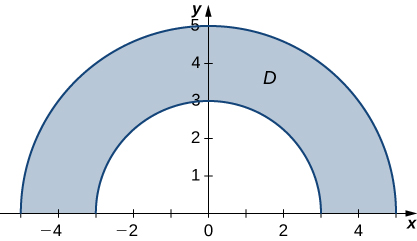
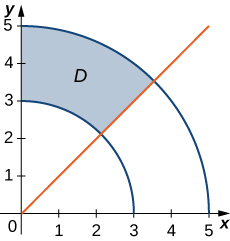
- Contestar
- D={(r,θ)|3≤r≤5, π4≤θ≤π2}
12)

13)
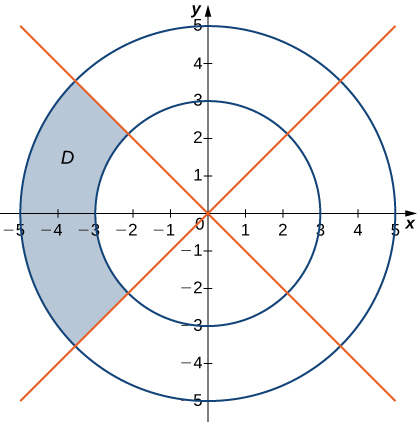
- Contestar
- D={(r,θ)|3≤r≤5, 3π4≤θ≤5π4}
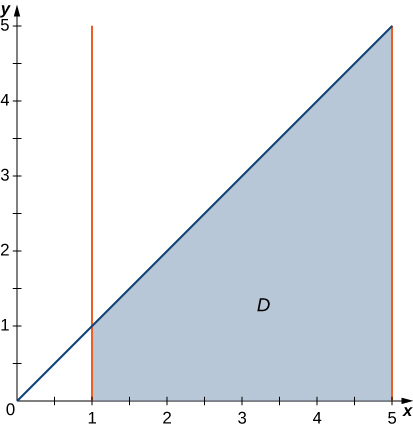
15) En la siguiente gráfica, la regiónD está delimitada pory=x yy=x2.
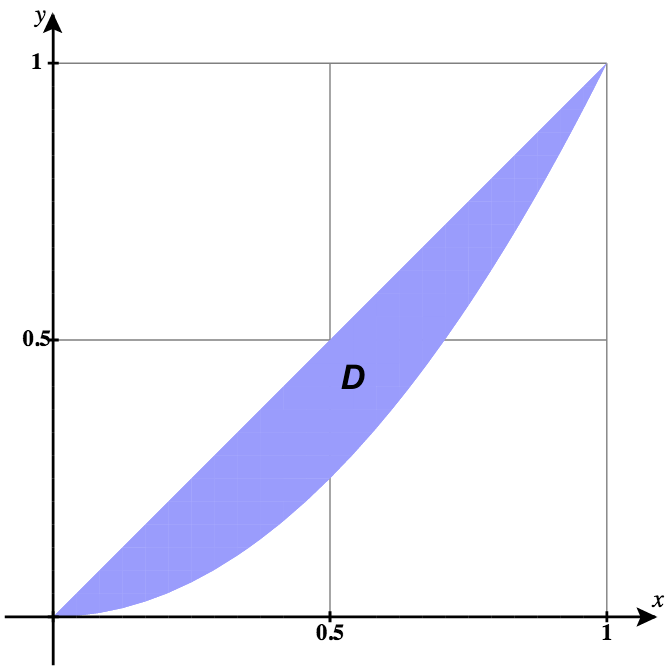
- Contestar
- D={(r,θ)|0≤r≤tanθ secθ, 0≤θ≤π4}
Evaluating Polar Double Integrals
In exercises 16 - 25, evaluate the double integral ∬Rf(x,y)dA over the polar rectangular region R.
16) f(x,y)=x2+y2, R={(r,θ)|3≤r≤5, 0≤θ≤2π}
17) f(x,y)=x+y, R={(r,θ)|3≤r≤5, 0≤θ≤2π}
- Answer
- 0
18) f(x,y)=x2+xy, R={(r,θ)|1≤r≤2, π≤θ≤2π}
19) f(x,y)=x4+y4, R={(r,θ)|1≤r≤2, 3π2≤θ≤2π}
- Answer
- 63π16
20) f(x,y)=3√x2+y2, where R={(r,θ)|0≤r≤1, π2≤θ≤π}.
21) f(x,y)=x4+2x2y2+y4, where R={(r,θ)|3≤r≤4, π3≤θ≤2π3}.
- Answer
- 3367π18
22) f(x,y)=sin(arctanyx), where R={(r,θ)|1≤r≤2, π6≤θ≤π3}
23) f(x,y)=arctan(yx), where R={(r,θ)|2≤r≤3, π4≤θ≤π3}
- Answer
- 35π2576
24) ∬Rex2+y2[1+2 arctan(yx)]dA, R={(r,θ)|1≤r≤2, π6≤θπ3}
25) ∬R(ex2+y2+x4+2x2y2+y4)arctan(yx)dA, R={(r,θ)|1≤r≤2, π4≤θ≤π3}
- Answer
- 7576π2(21−e+e4)
Converting Double Integrals to Polar Form
In exercises 26 - 29, the integrals have been converted to polar coordinates. Verify that the identities are true and choose the easiest way to evaluate the integrals, in rectangular or polar coordinates.
26) ∫21∫x0(x2+y2)dy dx=∫π40∫2 secθsecθr3dr dθ
27) ∫32∫x0x√x2+y2dy dx=∫π/40∫3secθ2secθr cosθ dr dθ
- Answer
- 52ln(1+√2)
28) ∫10∫xx21√x2+y2dy dx=∫π/40∫tanθ secθ0 dr dθ
29) ∫10∫xx2y√x2+y2dy dx=∫π/40∫tanθ secθ0r sinθ dr dθ
- Answer
- 16(2−√2)
In exercises 30 - 37, draw the region of integration, R, labeling all limits of integration, convert the integrals to polar coordinates and evaluate them.
30) ∫30∫√9−y20(x2+y2)dx dy
31) ∫20∫√4−y2−√4−y2(x2+y2)2dx dy
- Answer
- ∫π0∫20r5dr dθ=32π3
32) ∫10∫√1−x20(x+y) dy dx
33) ∫40∫√16−x2−√16−x2sin(x2+y2) dy dx
- Answer
- ∫π/2−π/2∫40r sin(r2) dr dθ=π sin28
34) ∫50∫√25−x2−√25−x2√x2+y2dydx
35) ∫4−4∫0−√16−y2(2y−x)dxdy
- Answer
- ∫3π2π2∫40(2rsinθ−rcosθ)rdr dθ=1283
36) ∫20∫√8−y2y(x+y)dxdy
37) ∫−1−2∫√4−x20(x+5)dydx+∫1−1∫√4−x2√1−x2(x+5)dydx+∫21∫√4−x20(x+5)dydx
- Answer
- ∫π0∫21(rcosθ+5)rdr dθ=15π2
38) Evaluate the integral ∬DrdA where D is the region bounded by the polar axis and the upper half of the cardioid r=1+cosθ.
39) Find the area of the region D bounded by the polar axis and the upper half of the cardioid r=1+cosθ.
- Answer
- 3π4
40) Evaluate the integral ∬DrdA, where D is the region bounded by the part of the four-leaved rose r=sin2θ situated in the first quadrant (see the following figure).
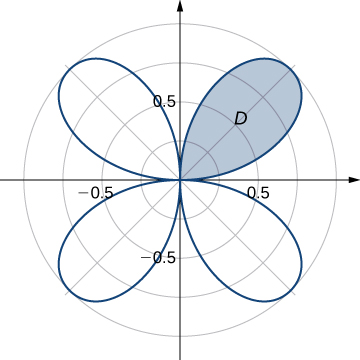
41) Encontrar el área total de la región encerrada por la rosa de cuatro hojasr=sin2θ (ver la figura en el ejercicio anterior).
- Contestar
- π2
42) Encontrar el área de la regiónD que es la región delimitada pory=√4−x2,x=√3,x=2, yy=0.
43) Encuentra el área de la regiónD, que es la región dentro del discox2+y2≤4 y a la derecha de la líneax=1.
- Contestar
- 13(4π−3√3)
44) Determinar el valor promedio de la funciónf(x,y)=x2+y2 sobre la regiónD delimitada por la curva polarr=cos2θ, donde−π4≤θ≤π4 (ver la siguiente gráfica).
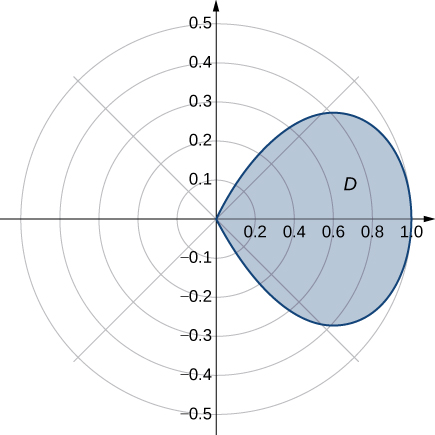
45) Determinar el valor promedio de la funciónf(x,y)=√x2+y2 over the region D bounded by the polar curve r=3sin2θ, where 0≤θ≤π2 (see the following graph).
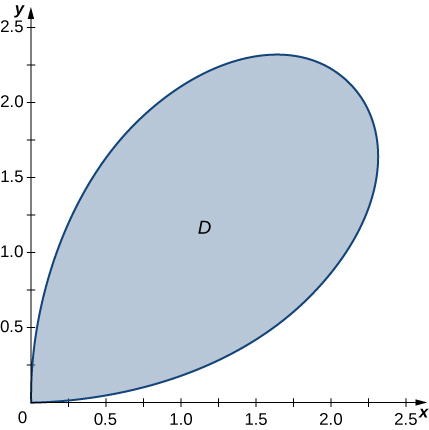
- Contestar
- 163π
46) Encontrar el volumen del sólido situado en el primer octante y delimitado por el paraboloidez=1−4x2−4y2 y los planosx=0, y=0, yz=0.
47) Encontrar el volumen del sólido delimitado por el paraboloidez=2−9x2−9y2 y el planoz=1.
- Contestar
- π18
48)
- Encuentra el volumen del sólidoS1 delimitado por el cilindrox2+y2=1 y los planosz=0 yz=1.
- Encuentra el volumen del sólidoS2 fuera del cono doblez2=x2+y2 dentro del cilindrox2+y2=1, y por encima del planoz=0.
- Encuentra el volumen del sólido dentro del conoz2=x2+y2 y debajo del planoz=1 restando los volúmenes de los sólidosS1 yS2.
49)
- Encuentra el volumen del sólidoS1 dentro de la esfera unitariax2+y2+z2=1 y por encima del planoz=0.
- Encuentra el volumen del sólidoS2 dentro del cono doble(z−1)2=x2+y2 y por encima del planoz=0.
- Encuentra el volumen del sólido fuera del cono doble(z−1)2=x2+y2 y dentro de la esferax2+y2+z2=1.
- Contestar
- a.2π3; b.π2; c.π6
En los Ejercicios 50-51 se presentan dobles integrales especiales que son especialmente adecuadas para la evaluación en coordenadas polares.
50) La superficie de un cono circular derecho con alturah y radio base sea puede describir mediante la ecuaciónf(x,y)=h−h√x2a2+y2a2, donde se encuentra la punta del cono(0,0,h) y la base circular se encuentra en elxy plano, centrada en el origen.
Confirmar que el volumen de un cono circular derecho con alturah y radio basea esV=13πa2h evaluando∫∫Rf(x,y)dA en coordenadas polares.
51) Considerar a∫∫Re−(x2+y2)dA.
) ¿Por qué es difícil evaluar esta integral en coordenadas rectangulares, independientemente de la regiónR?
(b)R Sea la región delimitada por el círculo de radioa centrado en el origen. Evaluar la doble integral usando coordenadas polares.
(c) Tomar el límite de su respuesta de (b), comoa→∞. ¿Qué implica esto sobre el volumen bajo la superficie dee−(x2+y2) todo elxy plano?
Para los dos ejercicios siguientes, considere un anillo esférico, que es una esfera con un agujero cilíndrico cortado para que el eje del cilindro pase por el centro de la esfera (ver la siguiente figura).

52) Si la esfera tiene radio 4 y el cilindro tiene radio 2 encuentra el volumen del anillo esférico.
53) Un orificio cilíndrico de 6 cm de diámetro se perfora a través de una esfera de radio de 5 cm de tal manera que el eje del cilindro pasa por el centro de la esfera. Encuentra el volumen del anillo esférico resultante.
- Contestar
- 256π3 cm3
54) Find the volume of the solid that lies under the double cone z2=4x2+4y2, inside the cylinder x2+y2=x, and above the plane z=0.
55) Find the volume of the solid that lies under the paraboloid z=x2+y2, inside the cylinder x2+y2=1 and above the plane z=0.
- Answer
- 3π32
56) Find the volume of the solid that lies under the plane x+y+z=10 and above the disk x2+y2=4x.
57) Find the volume of the solid that lies under the plane 2x+y+2z=8 and above the unit disk x2+y2=1.
- Answer
- 4π
58) A radial function f is a function whose value at each point depends only on the distance between that point and the origin of the system of coordinates; that is, f(x,y)=g(r), where r=√x2+y2. Show that if f is a continuous radial function, then
∬Df(x,y)dA=(θ2−θ1)[G(R2)−G(R1)], where G′(r)=rg(r) and (x,y)∈D={(r,θ)|R1≤r≤R2, 0≤θ≤2π}, with 0≤R1<R2 and 0≤θ1<θ2≤2π.
59) Use the information from the preceding exercise to calculate the integral ∬D(x2+y2)3dA, where D is the unit disk.
- Answer
- π4
60) Let f(x,y)=F′(r)r be a continuous radial function defined on the annular region D={(r,θ)|R1≤r≤R2, 0≤θ≤2π}, where r=√x2+y2, 0<R1<R2, and F is a differentiable function.
Show that ∬Df(x,y)dA=2π[F(R2)−F(R1)].
61) Apply the preceding exercise to calculate the integral ∬De√x2+y2√x2+y2dx dy where D is the annular region between the circles of radii 1 and 2 situated in the third quadrant.
- Answer
- 12πe(e−1)
62) Let f be a continuous function that can be expressed in polar coordinates as a function of θ only; that is, f(x,y)=h(θ), where (x,y)∈D={(r,θ)|R1≤r≤R2, θ1≤θ≤θ2}, with 0≤R1<R2 and 0≤θ1<θ2≤2π.
Show that ∬Df(x,y)dA=12(R22−R21)[H(θ2)−H(θ1)], where H is an antiderivative of h.
63) Apply the preceding exercise to calculate the integral ∬Dy2x2dA, where D={(r,θ)|1≤r≤2, π6≤θ≤π3}.
- Answer
- √3−π4
64) Let f be a continuous function that can be expressed in polar coordinates as a function of θ only; that is f(x,y)=g(r)h(θ), where (x,y)∈{(r,θ)|R1≤r≤R2, θ1≤θ≤θ2} with 0≤R1<R2 and 0≤θ1<θ2≤2π. Show that ∬Df(x,y)dA=[G(R2)−G(R1)] [H(θ2)−H(θ1)], where G and H are antiderivatives of g and h, respectively.
65) Evaluate ∬Darctan(yx)√x2+y2dA, where D={(r,θ)|2≤r≤3, π4≤θ≤π3}.
- Answer
- 133864π2
66) A spherical cap is the region of a sphere that lies above or below a given plane.
a. Show that the volume of the spherical cap in the figure below is 16πh(3a2+h2).
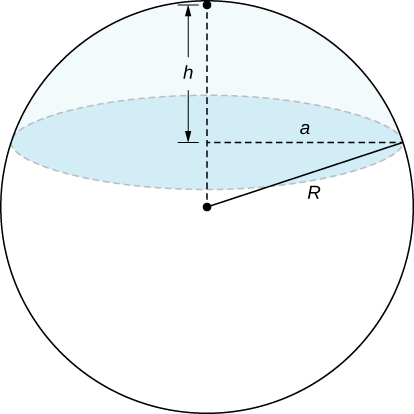
b. Un segmento esférico es el sólido definido por la intersección de una esfera con dos planos paralelos. Si la distancia entre los planos esh mostrar que el volumen del segmento esférico en la siguiente figura es16πh(3a2+3b2+h2).
b." data-type="media" id="fs-id1167793495515"> b." src="https://math.libretexts.org/@api/dek...15_03_212.jpeg">
67) En estadística, la densidad conjunta para dos eventos independientes, normalmente distribuidos con una media
- Template:ContribOpenStaxCalc
- Problems 1, 2, 34 - 37 and 50 - 51 are from Apex Calculus, Chapter 13.3
- Edited by Paul Seeburger (Monroe Community College)

